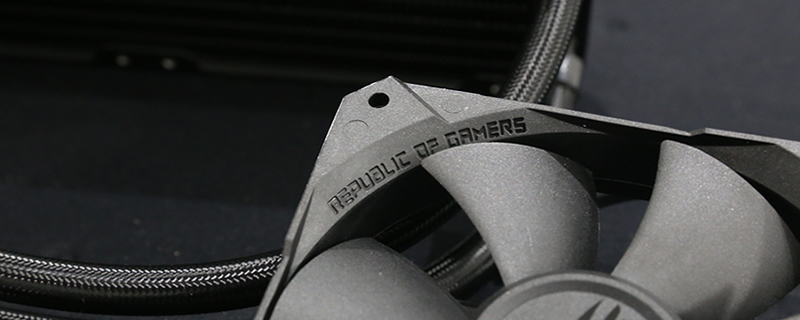ASUS ROG Ryuo 240 and Ryujin 360 AIO Liquid Cooler Review
Conclusion Â
There is a lot to unpack here, so much so that the writing of this conclusion is somewhat daunting. We like the Ryuo and the Ryujin, but several issues have added up to place us in a tricky position, especially when it comes to the Ryujin 360.Â
Over the past few years, Closed-Loop Liquid Coolers (CLCs) have been tweaked and tweaked again to lots of highly refined AIOs across almost every major brand, from Corsair to NZXT and now ASUS. For the most part, this has left the performance of ASUS’ AIOs in a similar position that’s similar to competing 240mm and 360mm CLC offerings. However, ASUS has a selling point that the others lack, which comes in the form of the inclusion of a 1.77-inch OLED screen on both their Ryuo and Ryujin units.Â
For both units, this screen can be used to convey useful data to end-users, from their CPU’s current clock speeds to specific temperature readings and other data. Other users may also use this feature to display a custom image or animation, showing your brand logo, online avatar or perhaps a comical GIF. This feature adds a level of customisability that ASUS’ competitors lack, making it a valid reason for choosing a ROG AIO over competing units.Â
When looking at ASUS’ ROG CLC lineup as a whole, we must make a note of a major downside that currently prevents these AIOs from reaching their full potential, AI Suite. As we mentioned on the previous page, AI Suite reads a motherboard-based temperature sensor and lists it as a “CPU” temperature, later using it to define fan profiles. Heat takes time to get from the CPU to ASUS’ thermal probe, allowing temperatures to spike under specific workloads. This design misstep can place ASUS behind their competition, though it can be worked around by end-users with custom fan profiles.Â
All ASUS needs to do to rectify this issue is to act like their competitors and use the in-CPU temperature sensors of AMD and Intel processors, which will negate this issue entirely. We are perplexed about why AI Suite doesn’t already do this, as this has been an issue with AI suite in the past, but now that the software controls CLC liquid coolers, the problem has moved from being a minor inconvenience to become a serious design flaw. This is an issue that will be a minor inconvenience for the average user but will act as a severe turn-off for high-end customers. Please address this ASUS.Â
 Â
Otherwise, the build quality of ASUS’ AIOs are stellar, their packaging is more than enough to keep each unit protected during transit, and their appearance will be more than good enough to satisfy most users, especially ardent ROG junkies.Â
ROG Ryuo 240
When it comes to the ROG Ryuo (the “Dragon King”), it’s major selling point (outside of the fact it’s a ROG AIO) is the unit’s OLED screen. This screen is the perfect size for the pump/top and can provide users with useful information or a neat adjustment option that could be used to make your PC that little more unique.
If you work around AI Suite’s shortcomings, you will find a cooler that easily competes with other high-end 240mm AIOs and ASUS’ included fans offer respectable noise levels and can be adjusted to create an incredibly quiet system. If ARGB lighting is your thing, the Ryuo also has you covered, making the ROG Ryuo 240 more than worthy of the OC3D Exceptional Aesthetics Award.  Â
To be honest, we would love to see ASUS create an ROG Ryuo 360, as we honestly prefer the appearance of the Ryuo to its bigger brother.Â
ROG Ryujin 360
The Ryujin is a “Dragon God”, but to be honest, in this case, we’d rather be a king. Several factors add up that would make us consider other options.Â
For starters, we have the Ryujin’s in-block fan. Like all small fans, it needs to spin quickly to generate a lot of airflow, making its whirr an annoyance that we would prefer to be without. Our recommendation is to turn this fan off, unless of course your VRMs legitimately need the extra airflow. Most VRM designs are more than capable of running with passive airflow, and if it isn’t you either have an insane overclock, fans that are already integrated into the motherboard or a badly designed product. If you are pairing this cooler up with a high-end ASUS motherboard, you more than likely don’t need the additional VRM airflow.Â
ASUS’ inclusion of this fan also harms the design in other areas, as the bulky block only serves to make the unit’s 1.77-inch screen appear smaller, ruining what could be considered the Ryujin’s unique selling point (USP). Yes, it’s the same size as the Ryuo’s screen, but the bulky block that surrounds it only leaves us with the feeling that the screen could and should have been bigger.Â
The Ryujin has several flaws which would make us explore other options. We wouldn’t recommend rushing to purchase one. Nevertheless, is worthy of consideration and still deserves our OC3D approved award, which is our entry-level award. With a little work you can get great performance out of this cooler, but you will have to work around some issues.Â
 Â
You can join the discussion on ASUS’ ROG Ryuo and ROG Ryujin 360 on the OC3D Forums.Â
Video



